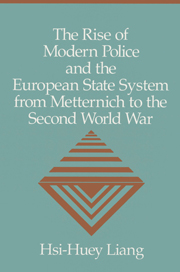Book contents
- Frontmatter
- Contents
- Abbreviations used in footnotes
- Preface
- Introduction: How do we define modern police?
- 1 Five national police styles in response to popular unrest in the nineteenth century
- 2 Modern police and the conduct of foreign policy. The French police and the recovery of France after 1871
- 3 International police collaboration from the 1870s to 1914 Professional contacts between police administrations
- 4 War and revolution, 1914–1922
- 5 The threat of totalitarianism. Nazi Germany's bid for European hegemony
- Epilogue
- List of archival files consulted
- Index
Introduction: How do we define modern police?
Published online by Cambridge University Press: 07 May 2010
- Frontmatter
- Contents
- Abbreviations used in footnotes
- Preface
- Introduction: How do we define modern police?
- 1 Five national police styles in response to popular unrest in the nineteenth century
- 2 Modern police and the conduct of foreign policy. The French police and the recovery of France after 1871
- 3 International police collaboration from the 1870s to 1914 Professional contacts between police administrations
- 4 War and revolution, 1914–1922
- 5 The threat of totalitarianism. Nazi Germany's bid for European hegemony
- Epilogue
- List of archival files consulted
- Index
Summary
Definitions in police literature
The literature on government of the past two centuries is rich in definitions of police. But many of these definitions are pompous and simplistic, and none of them tells us about the role the police played in the modern history of Europe. They are useful at best to make us see how the general concept of police has gradually changed during this period. Thus, under the influence of enlightened rationalism Joseph von Sonnenfels, the Austrian political economist, in 1765 called police a “science that teaches us how to create and cater to the domestic security of the state.” His contemporary, the Hanoverian publicist Johann von Justi, while basically of like mind, preferred to stress the benevolent side of royai despotism: “Police in the strict sense refers to everything needed for the maintenance of civil life, thus for discipline and order and well-being among the subjects in the towns, and for the growth of the peasantry.”
Today, these eighteenth–century definitions strike us as implausible because of their ready assumption that man has the intellectual power to devise a harmoniously policed society. (If Adam Smith can postulate an “economic man” to teach us how to increase the wealth of nations, they seem to say, why might not cameralist postulate a “policeable man” to explain the best way to free society from civil disorder?)
- Type
- Chapter
- Information
- The Rise of Modern Police and the European State System from Metternich to the Second World War , pp. 1 - 17Publisher: Cambridge University PressPrint publication year: 1992

